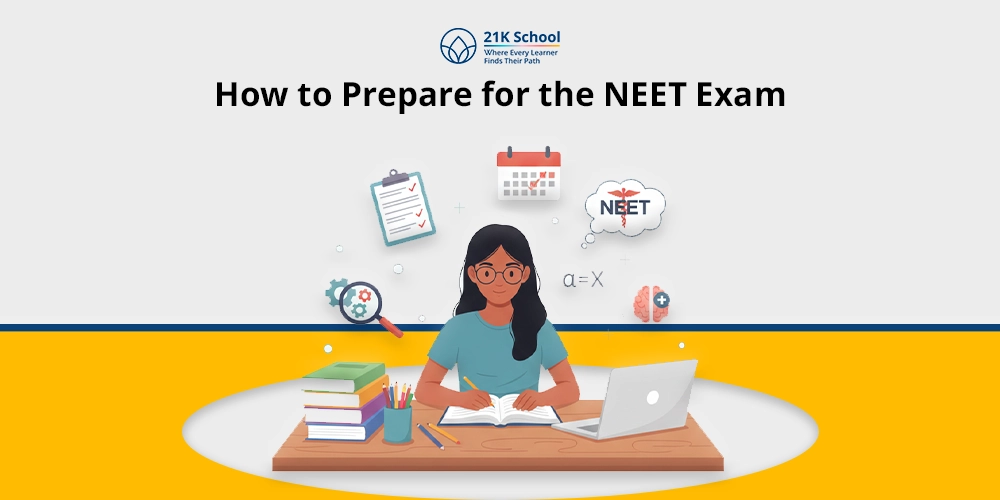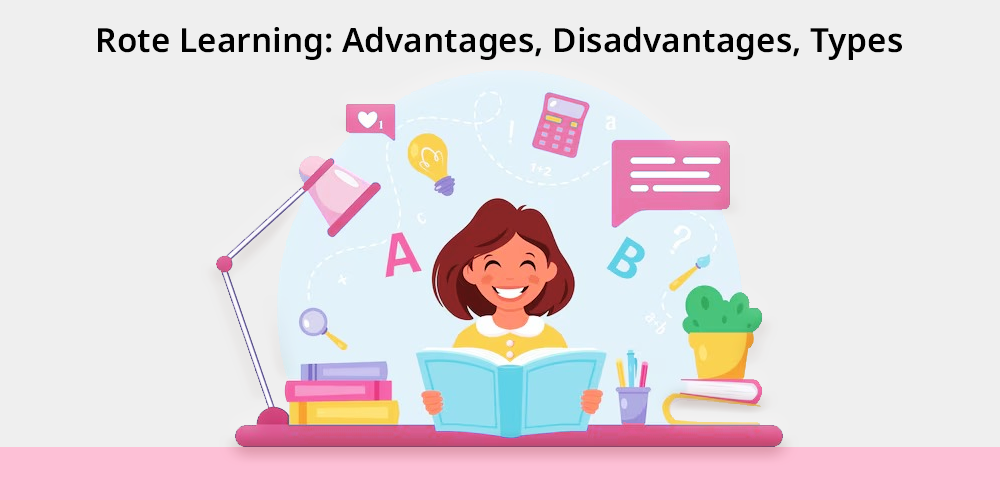
Do you know the meaning of rote learning?
Rote learning is a method of acquiring knowledge through memorisation of facts and figures. Rote learning is a memorisation technique which is associated with the traditional schooling method.
Rote learning is a technique that involves repeatedly memorising particular information. Rote learning enhances memory capacity to remember particular facts, dates or figures.
Rote learning mainly comprises memorising information and knowledge; however, memorisation is not considered ideal for developing a deeper understanding of concepts.
The rote learning method is not beneficial for long-term knowledge retention due to the fact that they are unable to relate theoretical aspects to real-life scenarios. Most students also focus on the rote learning methods to pass their examinations and to achieve good scores.
However, this method of learning hampers creativity and problem-solving skills .This creates difficulty in long-term career opportunities and future preparations.
Table of Contents
What is Rote Learning?
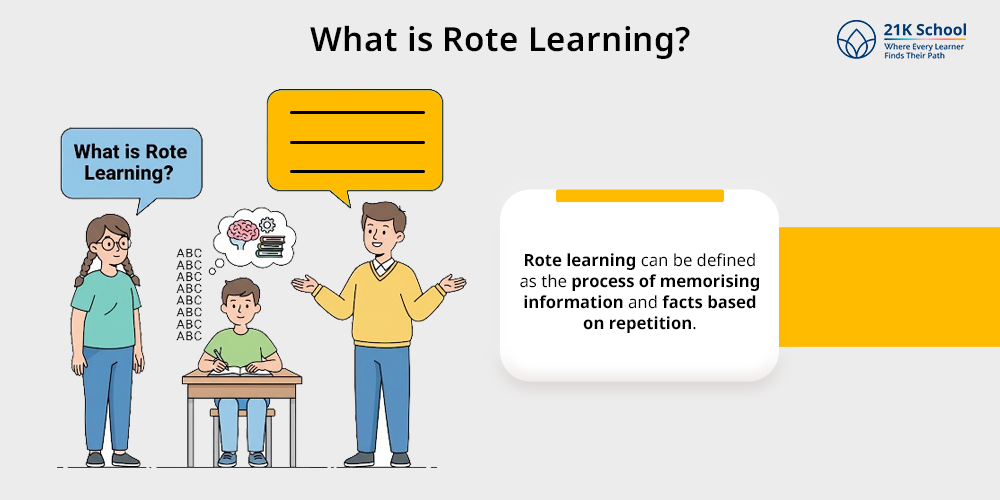
Rote learning can be defined as the process of memorising information and facts based on reputation. Rote learning allows students to recall knowledge quickly and efficiently.
Rote learning is related to the traditional method of schooling in which the focus was laid on reading and writing.
Rote learning is considered a bad and poor way of learning, however, rote learning allows students to enhance their memory focus and enhances their memory retention.
The rote learning method uses repetition that helps students to remember particular information.
One of rote learning’s main advantages is its capacity to help people remember particular facts, dates, history or figures.
The rote learning method helps in learning musical scales or historical dates. Rote learning also helps individuals to quickly recall specific information for work-related purposes.
Rote Learning in AI
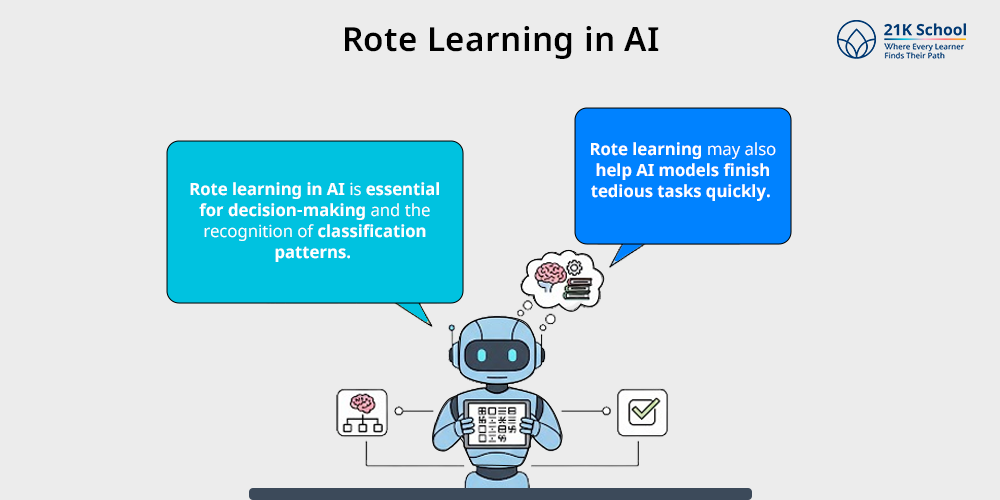
Rote learning is a essential part of basic AI operations. Rote learning in AI is essential for decision-making and the recognition of classification patterns.
Computers that have been trained through rote learning can recognize objects in speech patterns or images.
It is also insufficient for tasks that call for creativity or in-depth knowledge. Moreover, AI rote learning is limited to using data that has been stored in memory. AI uses memory and trained models to provide any information.
This became possible by the rote method that allows them to feed information to the automated system.
The majority of AI courses, such as the best AI online course in India, describe the basics of memorisation and its limitations.
On the other hand, rote learning may also help AI models finish tedious tasks quickly. When working with simple repetitive data, it saves processing time and effort.
Characteristics of Rote Learning
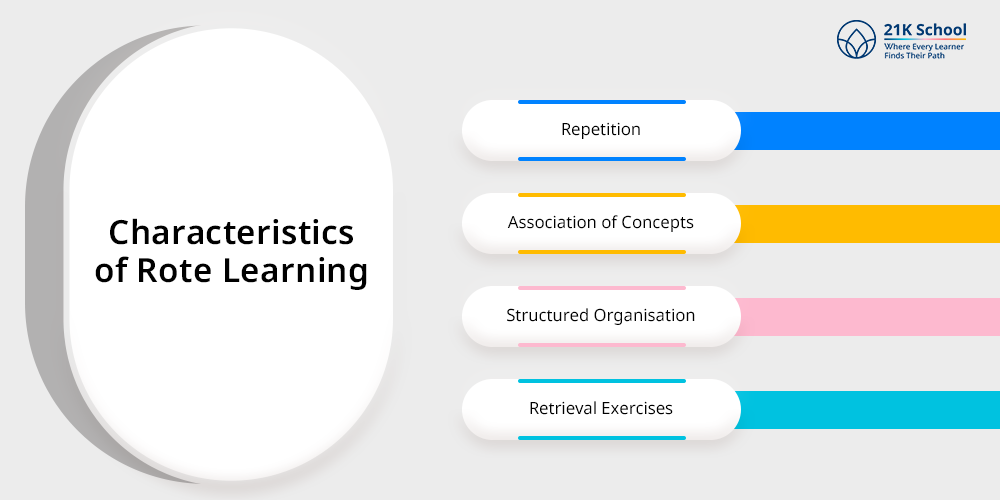
The rote learning method focuses on reading and writing on a repetitive basis, which allows individuals to memorise concepts for a shorter period of time.
Although it might work well for some kinds of information, it might not always encourage a thorough comprehension of the subject matter. The following are the characteristics of rote learning.
1. Repetition
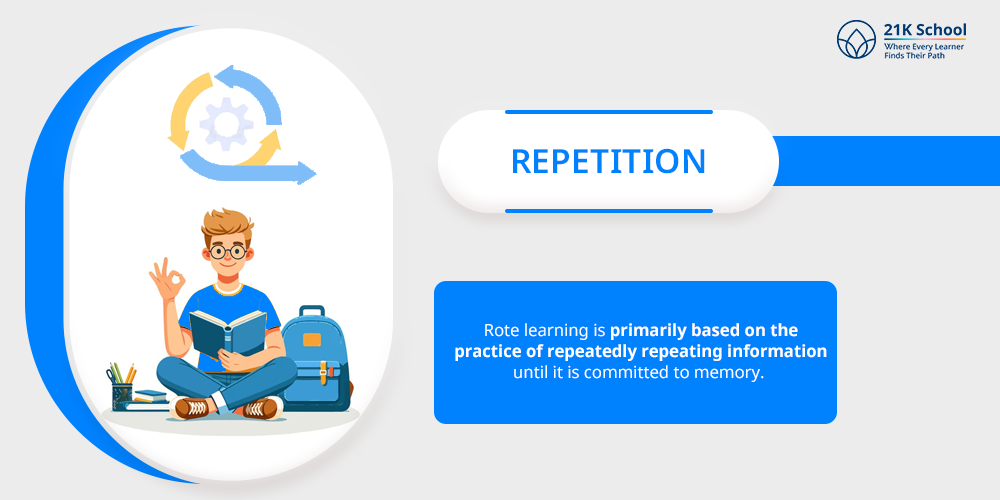
Rote learning is primarily based on the practice of repeatedly repeating information until it is committed to memory. This may entail repeatedly stating information, formulas or vocabulary.
It is believed that by repeatedly committing the material to memory, the learner will be better able to recall it later. Although this approach works especially well for short-term memorisation, and might not work for longer periods of time.
2. Association of Concepts
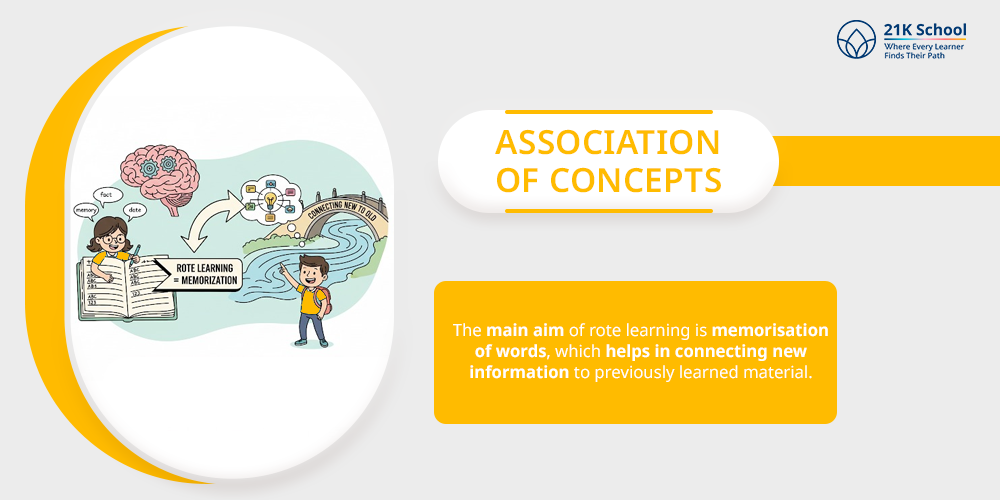
The main aim of rote learning is memorisation of words, which helps in connecting new information to previously learned material. This implies that students might make connections in their minds between new ideas and prior knowledge, which could help with recall.
A student learning a new language might, for instance, associate a new word with a word that sounds similar in their native tongue. By giving the information context, this method can improve memory retention.
3. Structured Organisation
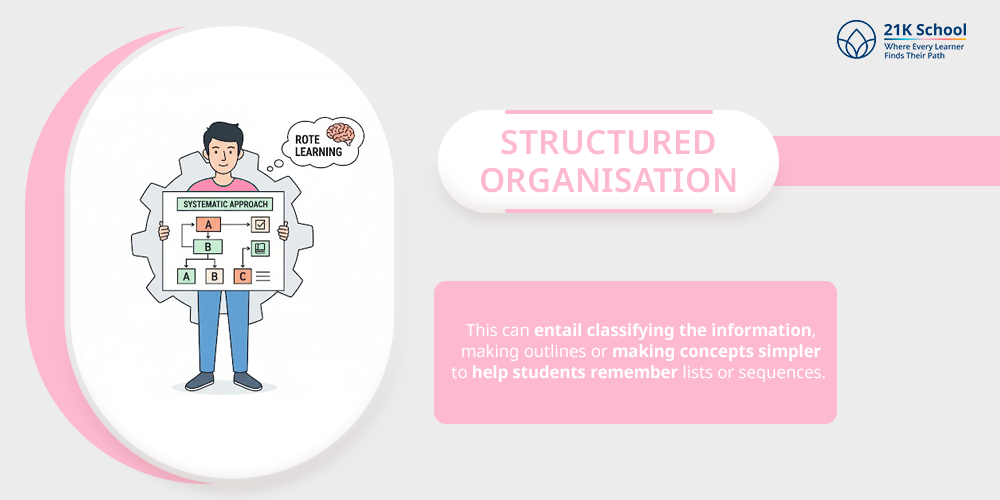
Rote learning includes a systematic approach to learning. This can entail classifying the information, making outlines or making concepts simpler to help students remember lists or sequences.
Information that is well-structured may be easier for learners to navigate and retain. For instance, charts and diagrams can aid students in remembering and visualising the relationships between concepts.
4. Retrieval Exercises
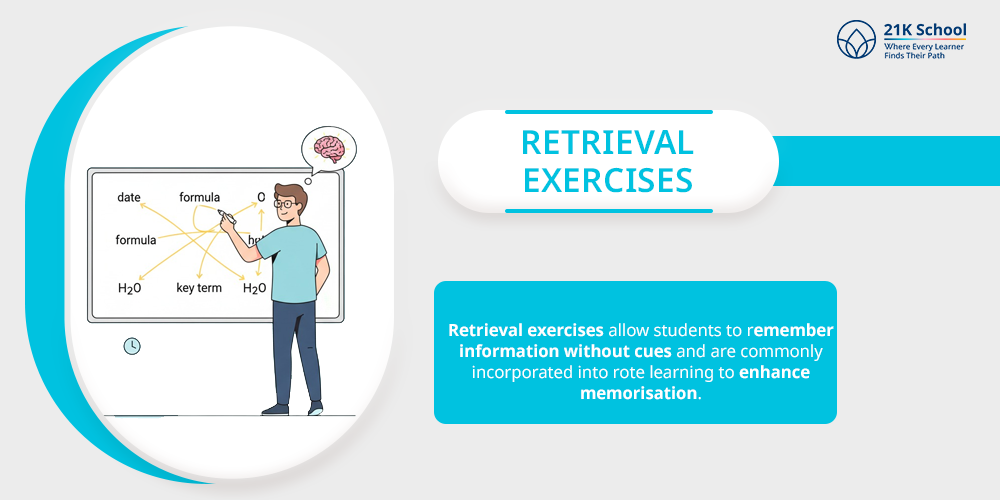
Retrieval exercises allow students to remember information without cues and are commonly incorporated into rote learning to enhance memorisation. This can be achieved through practising exams, flashcards, or quizzes.
Retrieval enhances memory networks, which facilitates later access to the information. Retrieval practice is essential to effective rote learning because it aids students in remembering what they have learned.
Types of Rote Learning
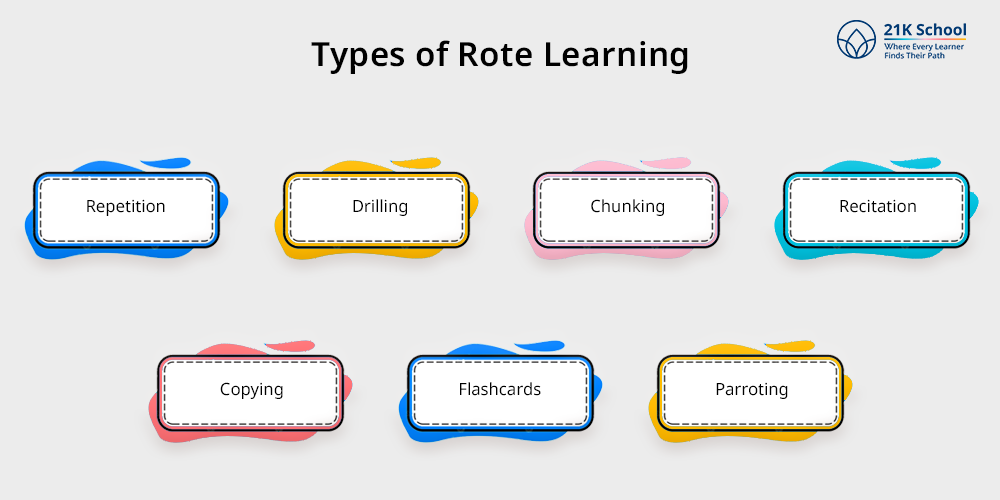
Rote learning involves repetitive information that allows students to focus on comprehension of material.
Rote learning is a basic and classic learning method that is commonly used to promote quick fact recall, which includes various types such as alphabet, multiplication tables, drilling, repetition, and so on.
The following are the types of rote learning methods mentioned below.
1. Repetition
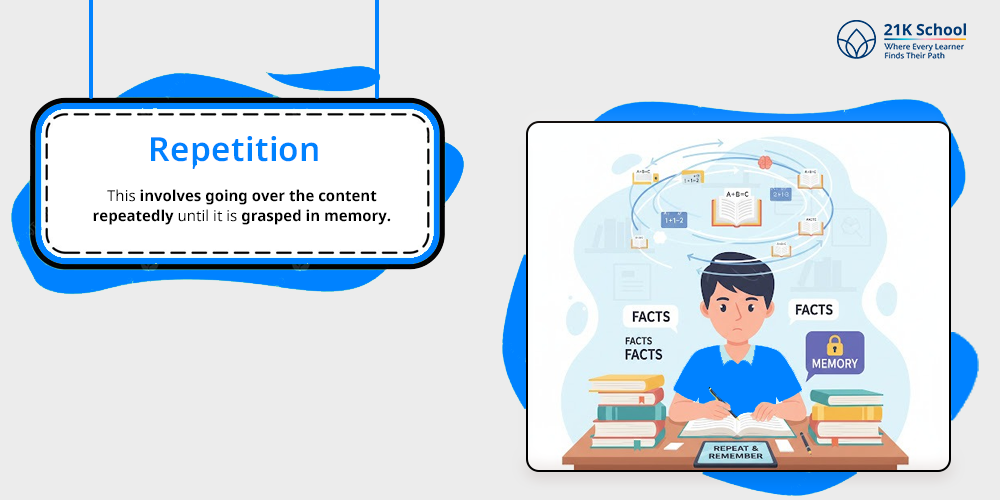
Repetition is a method of learning facts multiple times. This involves going over the content repeatedly until it is grasped in memory. The more times a learner studies a concept, the more likely they are to remember theories.
The repetition method is widely used for memorising facts, formulas and vocabulary. The rote learning method allows students to think from different angles and enables them to study as per the environmental situation.
2. Drilling
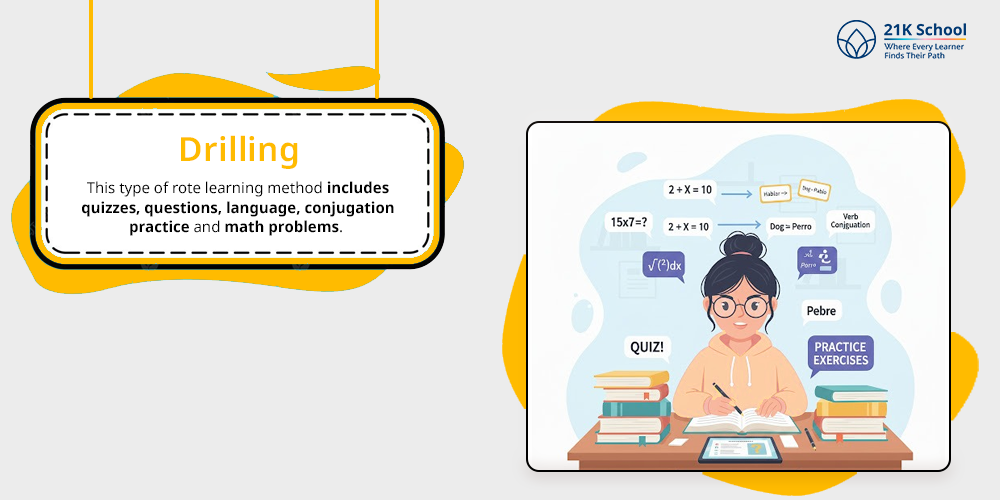
Drilling is a methodical approach of rote learning in which students practice specific skills or knowledge using exercises. This type of rote learning method includes quizzes, questions, language, conjugation practice and math problems.
According to this method of rote learning, students practice theories on a regular basis which enables them to enhance their knowledge retention for a shorter span of time.
3. Chunking
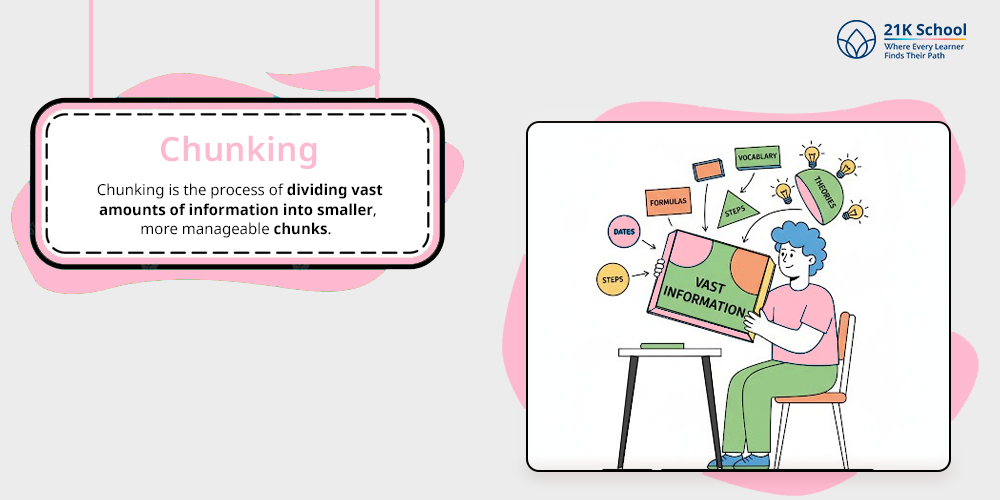
Chunking is another type of rote learning method. Chunking is the process of dividing vast amounts of information into smaller, more manageable chunks.
In this method students can put information into meaningful groups which makes it easier to remember long questions and concepts. This method facilitates knowledge retention through dividing difficult facts into a single aspect.
4. Recitation
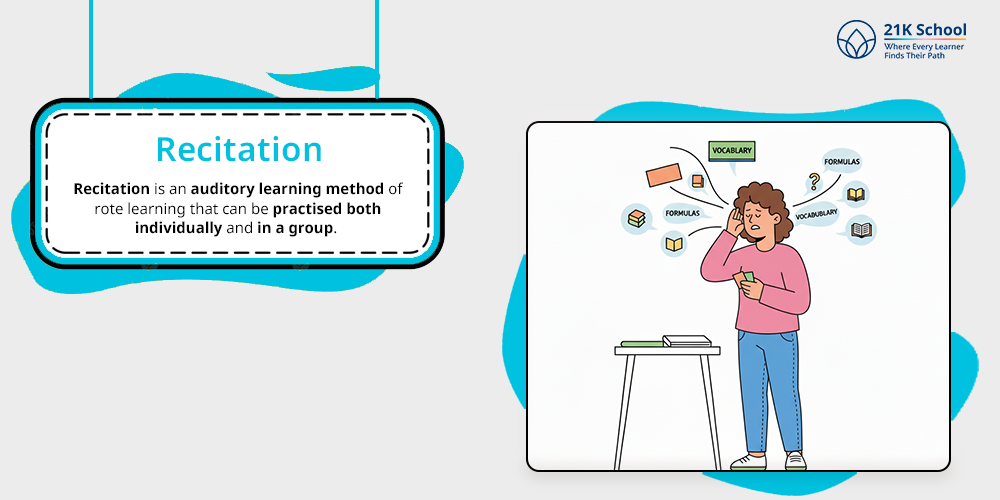
Recitation is an auditory learning method of rote learning that can be practised both individually and in a group. This technique improves memory retention and allows children to memorise for a longer period of time.
In this type of rote learning, students repeat information or read stories repeatedly. This method of learning is widely used by students for learning a language, studying historical dates, or memorising stories or facts.
5. Copying
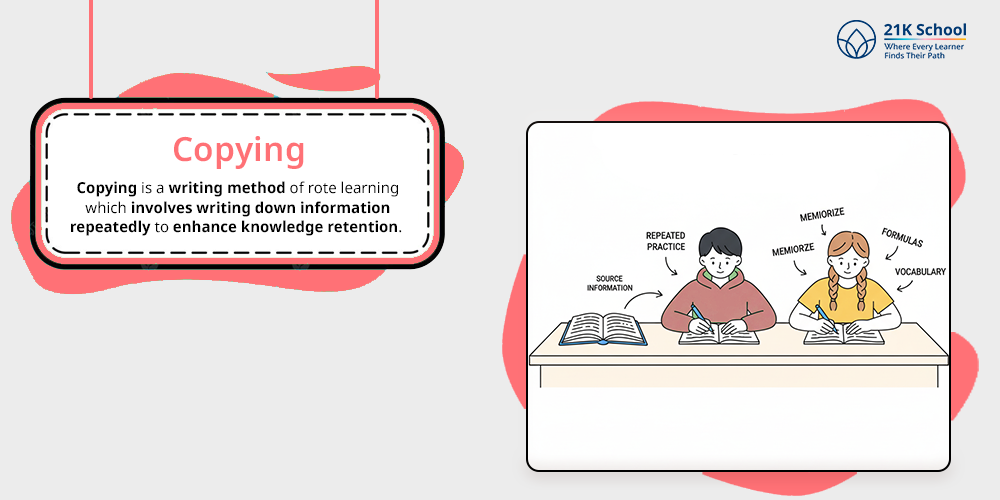
Copying is a writing method of rote learning which involves writing down information repeatedly to enhance knowledge retention.
This method of learning is considered as the best learning method to learn numeracy, formulas, vocabulary, grammar or spelling. This type of learning focuses on kinesthetic knowledge and enhances memory retention.
6. Flashcards
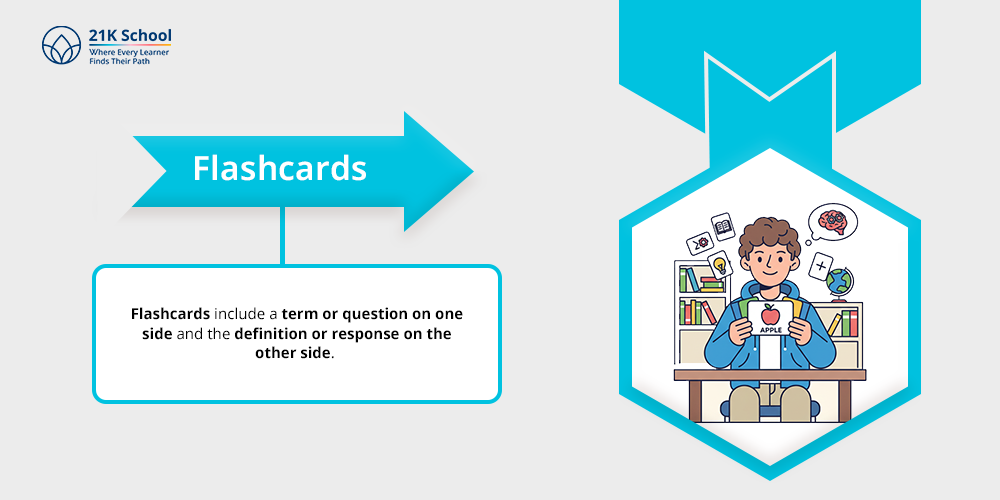
One common tool for rote learning is a flashcard, which has a term or question on one side and the definition or answer on the other.
Students can test themselves or have others test them to improve their memory through spaced repetition and active recall. Flash cards allow students to develop critical thinking skills and enhance their knowledge capacity.
7. Parroting
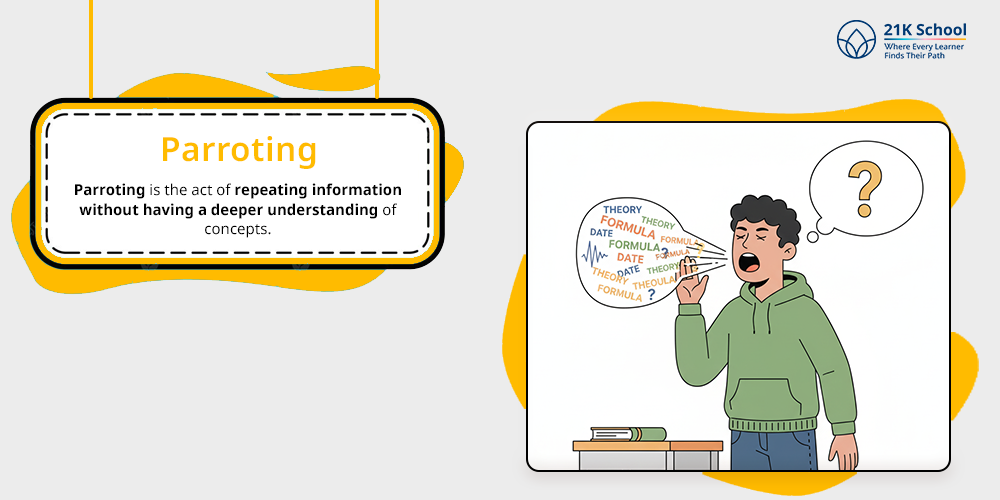
Parroting is the act of repeating information without having a deeper understanding of concepts. Imitating words or sentences is a common technique used in language learning to help students become more fluent and pronounce words correctly.
However, it might be effective for short-term memorisation; it might not promote deeper comprehension.
Rote Learning vs Meaningful Learning
Although meaningful learning and rote learning are two distinct ideas they are connected in some way.
Rote learning is the process of repeatedly memorising information, whereas meaningful learning places more emphasis on comprehending and connecting new information to past experiences.
Both concepts are essential for preparing the theoretical aspects of learning and are related to the traditional method of teaching and learning. Following are the distinctions between rote learning and meaningful learning.
| Aspect | Rote Learning | Meaningful Learning |
| Definition | Rote learning is the process of memorising information and facts based on reputation. This method focuses on the classical approach of teaching and learning. | Meaningful learning is the process of memorising new information in relation to past knowledge. This method allows students to make a deeper connection with the concepts. |
| Strategy | Rote learning uses flashcards, repetition, memorisation, cramming, reading, writing, and so on. | Meaningful learning uses concepts related to past knowledge and combines them to create a deeper understanding of facts and figures. |
| Benefits | Rote learning allows for quick recognition of theories and memorising concepts quickly for a shorter period of time. | Meaningful learning allows students to develop a deeper understanding of thoughts and knowledge. |
| Examples | Memorisation of multiplication tables, formulas, theories, grammar, etc., is an example of rote learning. | Analysing historical events, working principles, and contextual formulas is an example of meaningful learning. |
Rote Learning vs Conceptual Learning
Rote learning and conceptual learning are related to each other but both has different aspects of learning. Rote learning focuses on memorising theoretical aspects whereas conceptual learning focuses on grasping concepts of past knowledge.
Both the methods of learning focus on short-term memory retention and allow children to memorise difficult concepts. Following are the distinction between rote learning and conceptual learning.
| Aspect | Rote Learning | Conceptual Learning |
| Focus | Rote learning focuses on the basic foundation of knowledge through memorising basics. | Conceptual Learning focuses on deeper understanding of knowledge rather than basic knowledge. |
| Efficiency | Rote learning is more efficient as students have to remember the facts and figures for a shorter period of time. | Conceptual learning is time consuming as students have to understand the deeper knowledge of concepts. |
| Basis | Rote learning is based on simple consideration of memorisation rather than creativity and thinking skills. | Conceptual learning is based on critical thinking skills and problem solving skills. |
| Examples | Examples of rote learning are memorisation of multiplication tables, formulas, theories, grammar, etc. | One of the effective examples of conceptual learning is making connections between two concepts such as historical events. |
Examples of Rote Learning
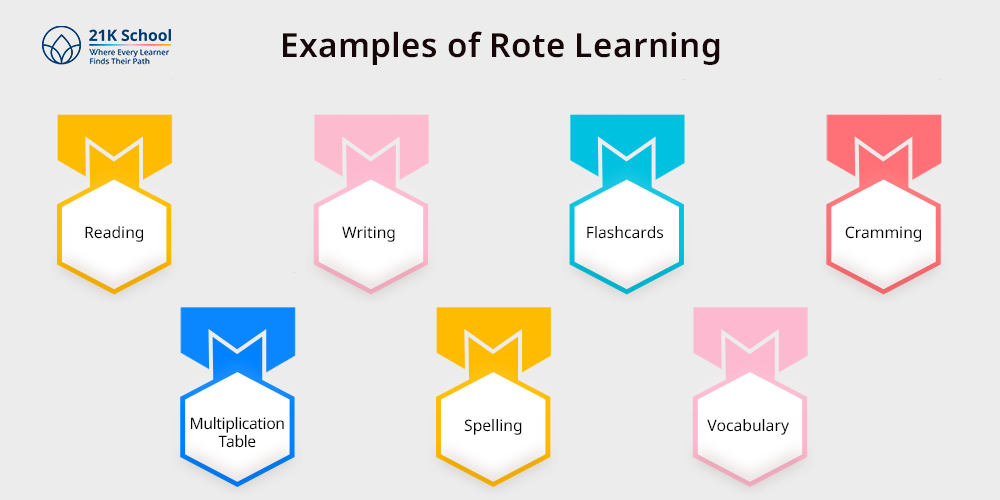
Rote learning is a method of memorising concepts without understanding its core meaning. It is the process of memorising concepts on a repetitive basis.
This allows students to think and memorise for a shorter period of time. Rote learning is a good method for memorising concepts quickly however, it is applicable for a short period of time. Here are the examples of rote learning methods.
1. Reading

Reading texts several times can aid students in learning to retain information, including definitions from science, historical documents, and literature.
This allows students to become accustomed to the content, this approach promotes retention through repeated exposure. This allows students to enhance their vocabulary skills and improve their knowledge retention.
2. Writing
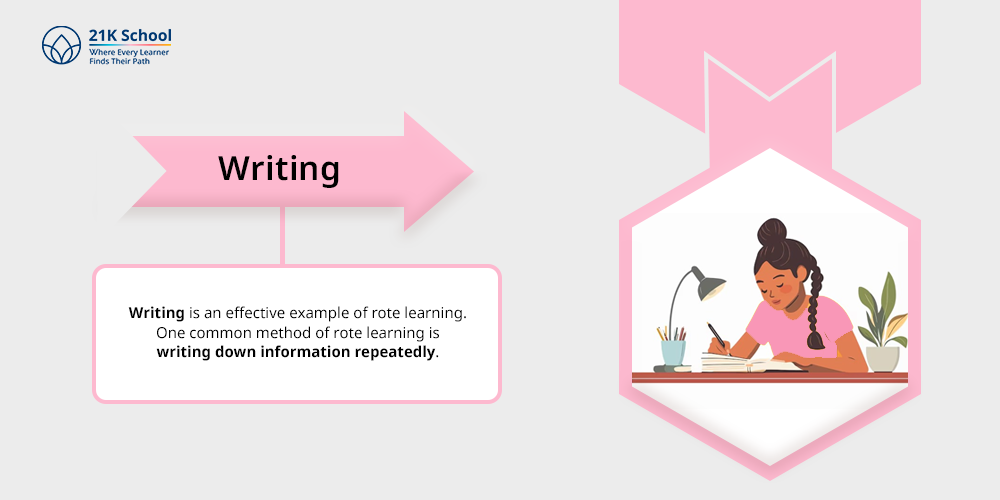
Writing is an effective example of rote learning. One common method of rote learning is writing down information repeatedly. Writing is a classic method of rote learning that focuses on passive education in which students learn by reading and writing.
This helps them remember things students might write definitions, formulas or key ideas several times. This approach improves retention by joining kinesthetic and visual learning.
3. Flashcards
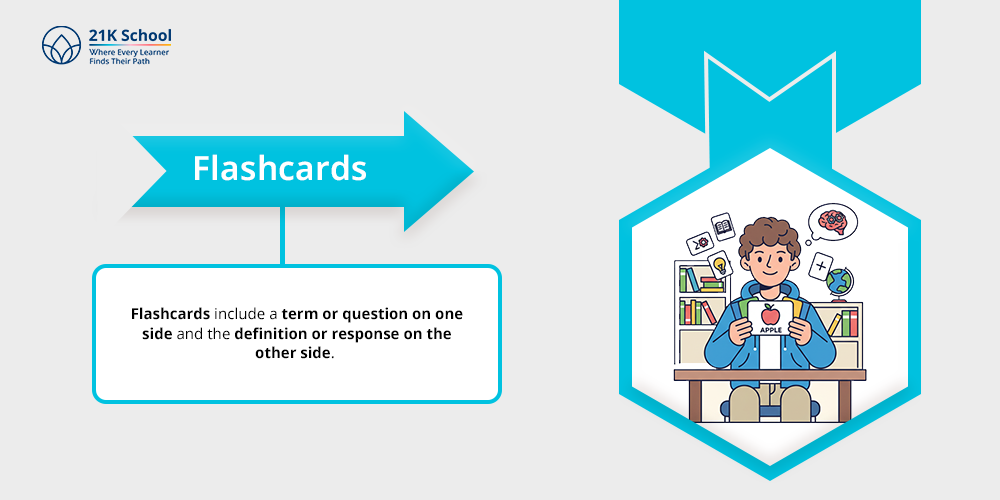
Flashcards are another common tool for rote learning. Flashcards include a term or question on one side and the definition or response on the other side.
In order to encourage active recall and reinforce memory through repetition, learners can use flashcards to test themselves or other people. The traditional schooling uses flashcard methods in which teachers use them to conduct assessments for students.
4. Cramming
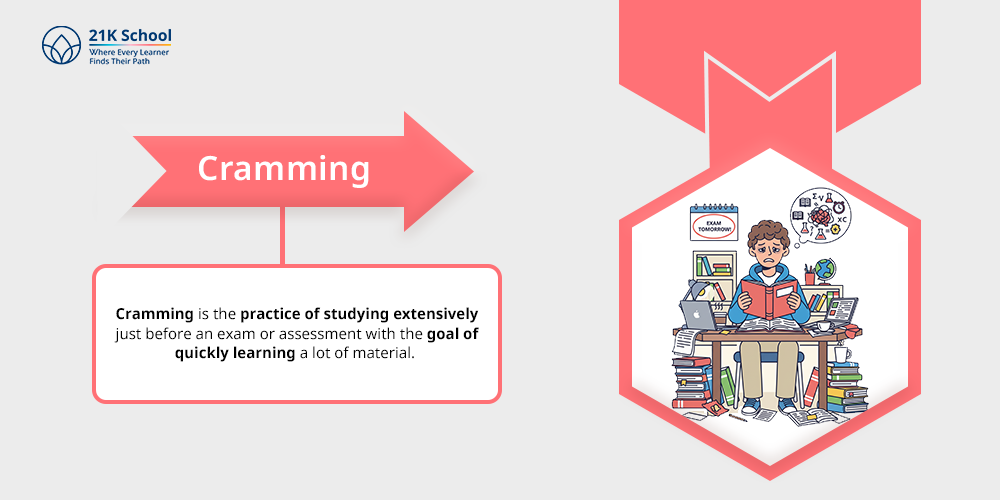
Cramming is an effective rote learning strategy that allows students to study quickly. Cramming is the practice of studying extensively just before an exam or assessment with the goal of quickly learning a lot of material.
Students frequently use this technique to quickly remember facts, formulas or concepts for a shorter period of time; however, this method is not suitable for a longer period of time.
5. Multiplication Table
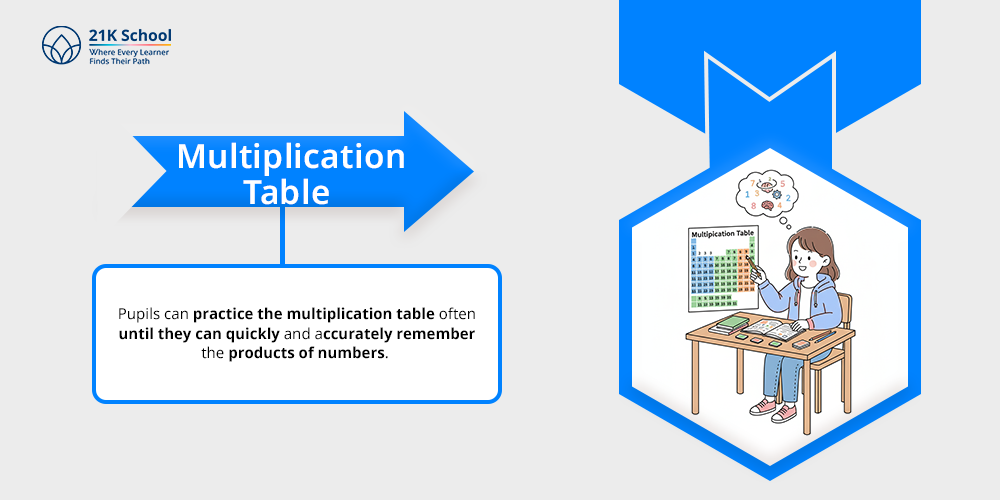
Learning the multiplication table is a classic example of rote learning. Pupils can practice the multiplication table often until they can quickly and accurately remember the products of numbers.
This essential skill is needed to understand more complicated mathematical concepts. Even in numerics and mathematics, rote learning is needed to grasp the basics of concepts and formulas.
6. Spelling

Rote learning is a common technique in spelling practice where students repeat words until they learn the correct spelling. Some strategies to improve memory include writing words several times, taking spelling tests or saying words out loud.
Spelling is very essential in improving vocabulary and language understanding. This method allows students to effectively understand literature and language instructions with limited errors.
7. Vocabulary

Vocabulary is another effective example of rote learning. Students frequently use rote memorisation to learn new vocabulary words, definitions, synonyms, alphabets, and usage to memory.
This method of rote learning allows students to learn new things and develop their own thoughts. This also assists them in understanding literature, language and syntax.
Advantages of Rote Learning
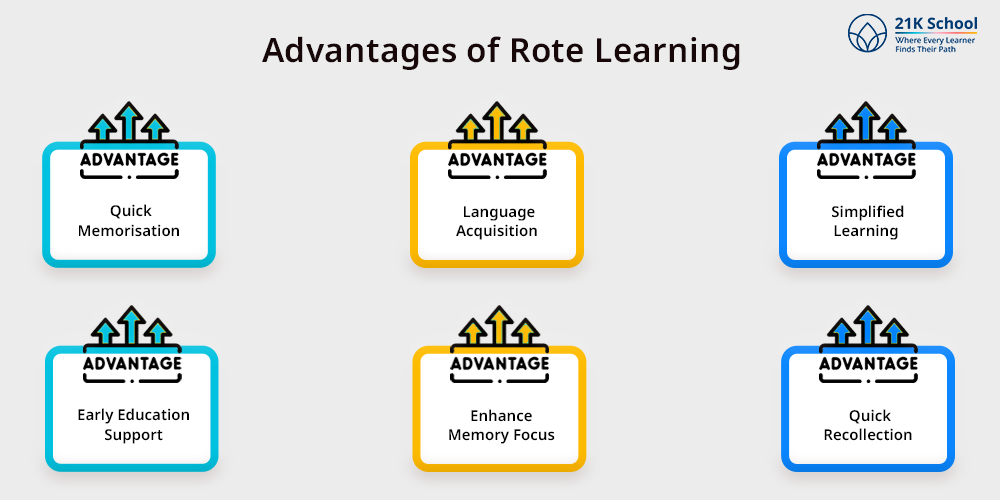
Many people consider rote learning an old method of memorisation that hampers creativity and crtitical thinking skills .
Rote learning methods allow students to recall concepts quickly and effectively, which encourages students to enhance their knowledge retention.
The procedure entails repeatedly drilling information into the memory until it is deeply embedded. The following are the advantages of rote learning.
1. Quick Memorisation

Rote learning allows students to quickly memorise longer concepts more efficiently. The rote learning method enables students to recall important information during exams and assessments.
This method of learning assists students to recall information or lengthy subjects such as English, Literature, History, Formulas and so on. This method allows students to rapidly recall factual information and formulas.
2. Language Acquisition
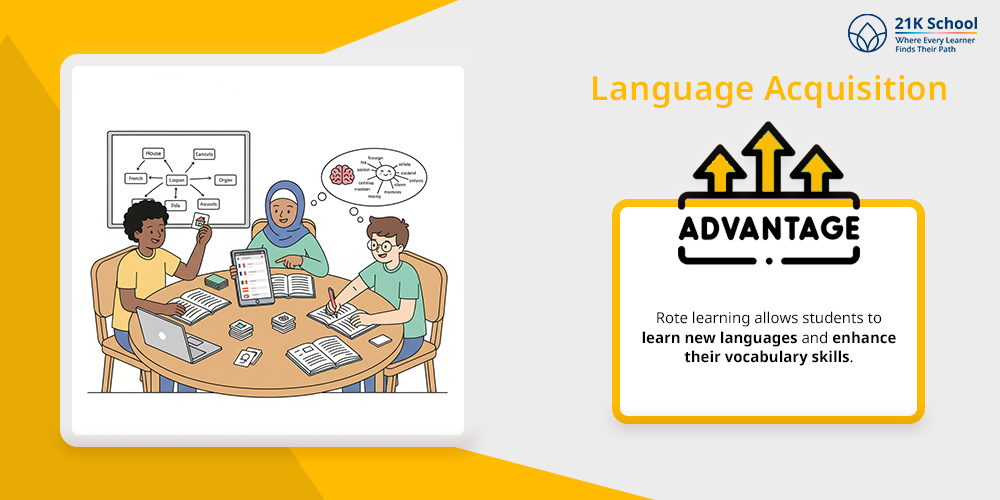
Rote learning allows students to learn new languages and enhance their vocabulary skills. Learning grammar, rules and alphabets repetitively helps in promoting knowledge acquisition.
Rote learning is known for linguistic development which allows students to develop knowledge retention. Memorising long concepts allows students to learn grammatical rules and syntax in a short span of time.
3. Simplified Learning
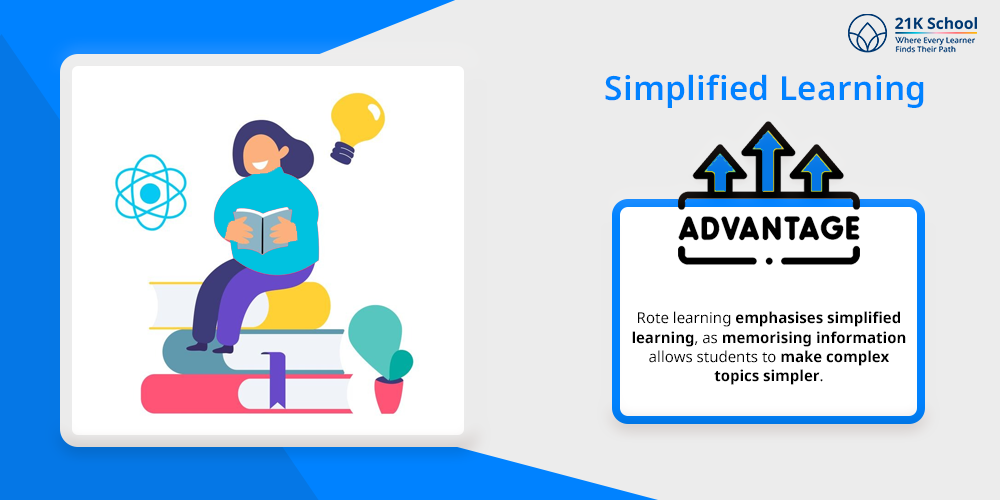
Rote learning emphasises simplified learning, as memorising information allows students to make complex topics simpler. Through rote learning, students can break down the complex topics into smaller sections, which enables them to memorise the facts in a shorter span of time.
This allows them to grasp difficult concepts and enables them to remember topics for a longer period of time. Memorising facts and figures allows them to develop a foundation for basic concepts and facts-based education.
4. Early Education Support
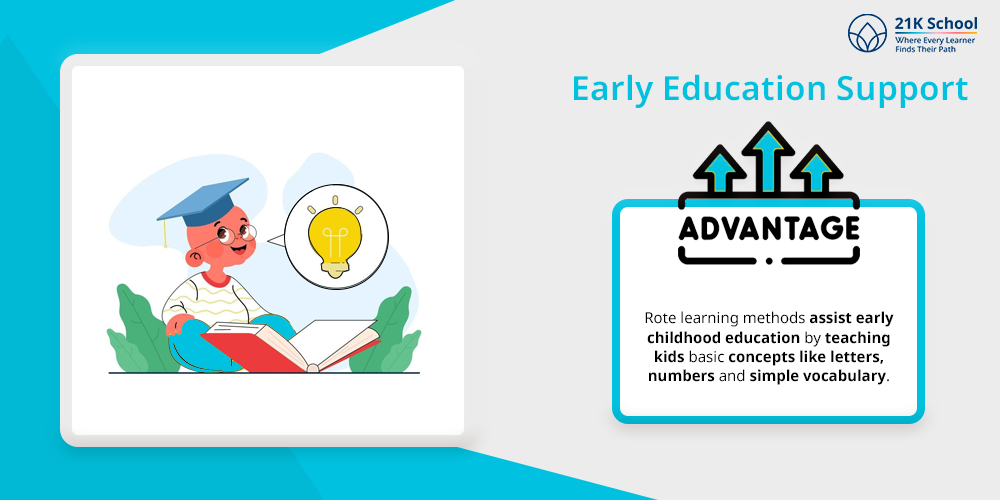
Rote learning methods assist early childhood education by teaching kids basic concepts like letters, numbers and simple vocabulary. This method helps in strengthening the memory of kids and creates a groundwork for further education.
This method of learning makes education simpler for kids as they are not capable of grasping difficult concepts. This method helps kids to enhance their knowledge retention and provide them with opportunities to explore the subjects and their theories.
5. Enhance Memory Focus

Rote learning enhances memory focus through repetition, which strengthens memory capacity among children. The repetitive nature of rote learning allows students to solidify their ability to grasp knowledge more frequently.
The rote method of learning is mainly acquired through short-term memory; however, with daily repetition, it can be transferred to long-term memory. This allows children to memorise concepts for a longer period of time.
6. Quick Recollection
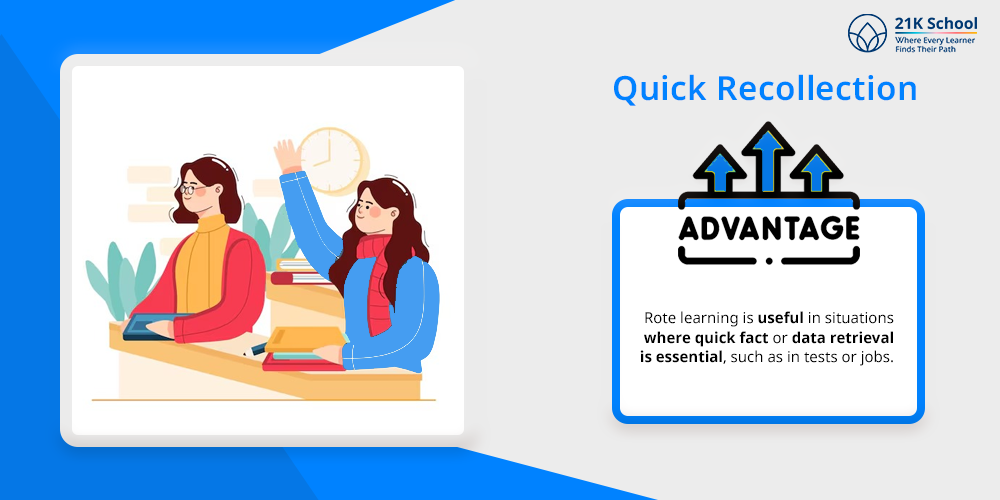
Rote learning enables quick information recall. Rote learning is useful in situations where quick fact or data retrieval is essential, such as in tests or jobs.
This provides quick knowledge retention and allows for transmission of knowledge for a shorter period of time. This method is useful for last-minute revisions and a quick overview.
Disadvantages of Rote Learning
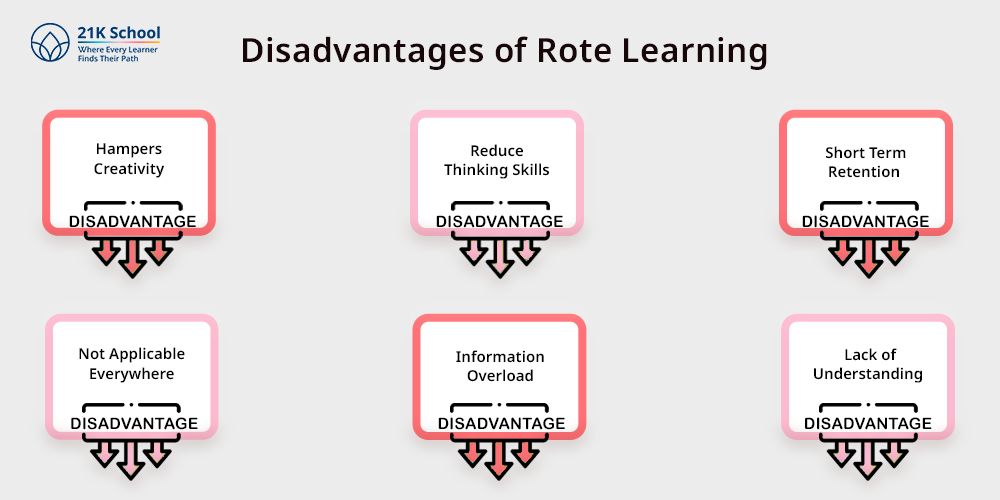
Rote learning emphasises memorisation of concepts and thoughts. Due to memorisation of concepts, it hampers logical and analytical thinking skills
Rote learning is beneficial for short-term memory retention however, it has some limitations that hamper creativity and limit the learning capacity of grasping knowledge more frequently. The following are the disadvantages of rote learning are mentioned below.
1. Hampers Creativity
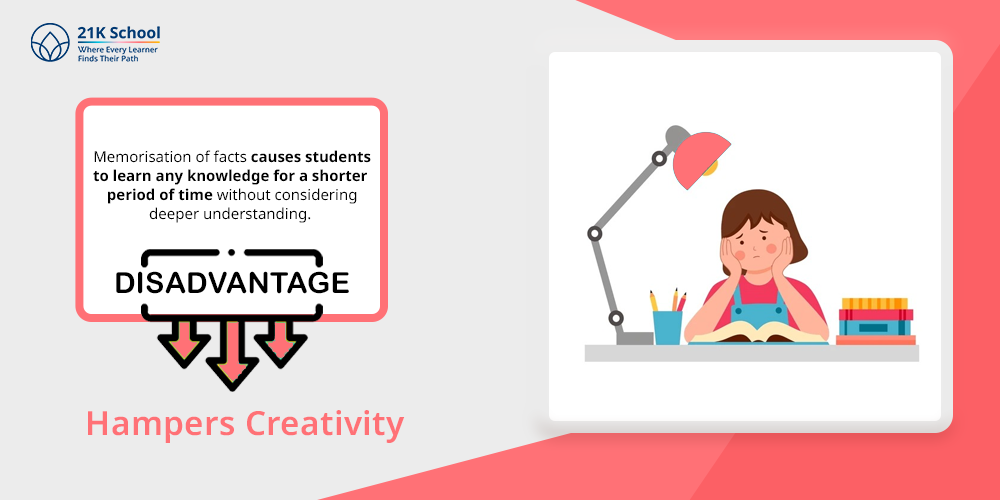
One of the major disadvantages of the rote learning method is that it hampers creative thinking skills . Memorisation of facts causes students to learn any knowledge for a shorter period of time without considering deeper understanding.
Rote learning only focuses on the theoretical aspect, which also hinders their practical aspect of grasping knowledge. This causes students to hamper their problem-solving skills as well as their critical thinking skills.
2. Reduce Thinking Skills
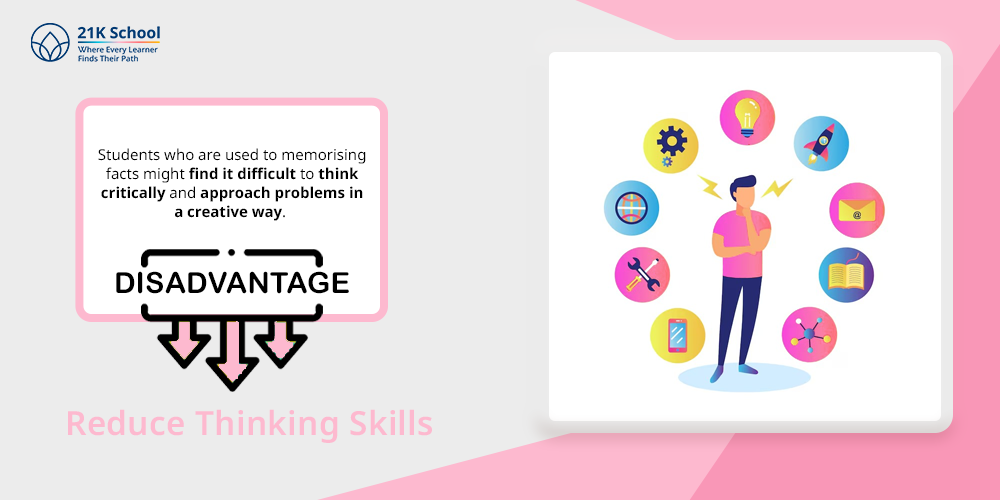
Creativity and independent thinking skills are often hampered by rote learning. Students who are used to memorising facts might find it difficult to think critically and approach problems in a creative way.
This reduces their thinking capabilities and suppresses their knowledge retention. Due to this, students may recall information for a shorter period of time due to which they may forget the knowledge.
3. Short Term Retention
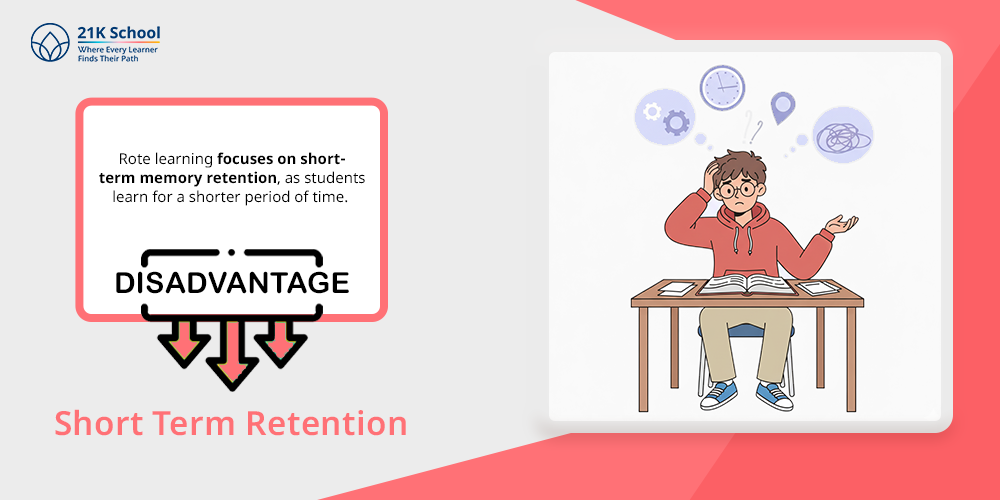
Rote learning focuses on short-term memory retention, as students learn for a shorter period of time. Without a deeper comprehension, it can be difficult for students to retain the information over time.
Due to a shorter span of knowledge, students find it difficult to gain practical exposure, which hinders them to adjust to real-life scenarios.
4. Not Applicable Everywhere
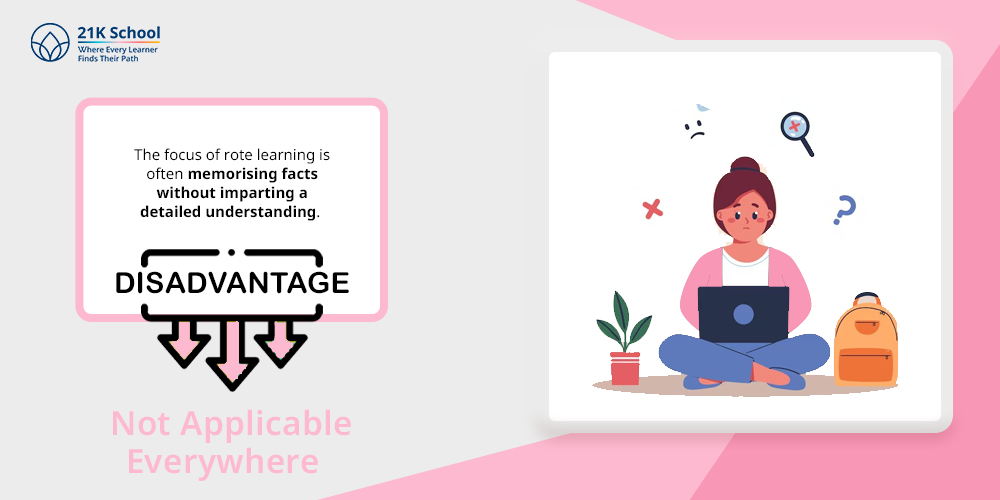
Rote learning mostly focuses on memorisation of facts and information. The focus of rote learning is often memorising facts without imparting a detailed understanding.
As rote learning is limited to theories only, and numerics and data require practical application. This could restrict the application of the knowledge to situations in the real world where understanding and adaptability are crucial.
5. Information Overload
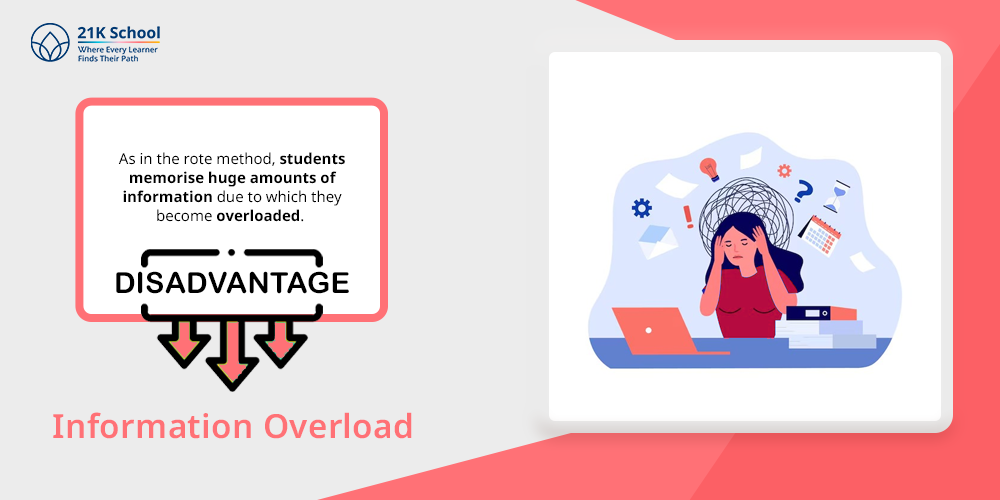
Information overload is another factor of rote learning. As in the rote method, students memorise huge amounts of information due to which they become overloaded.
Students may become overwhelmed by this traditional approach, which will hinder their ability to properly process and retain new information. This hampers students’ critical thinking and ability to process new information.
6. Lack of Understanding
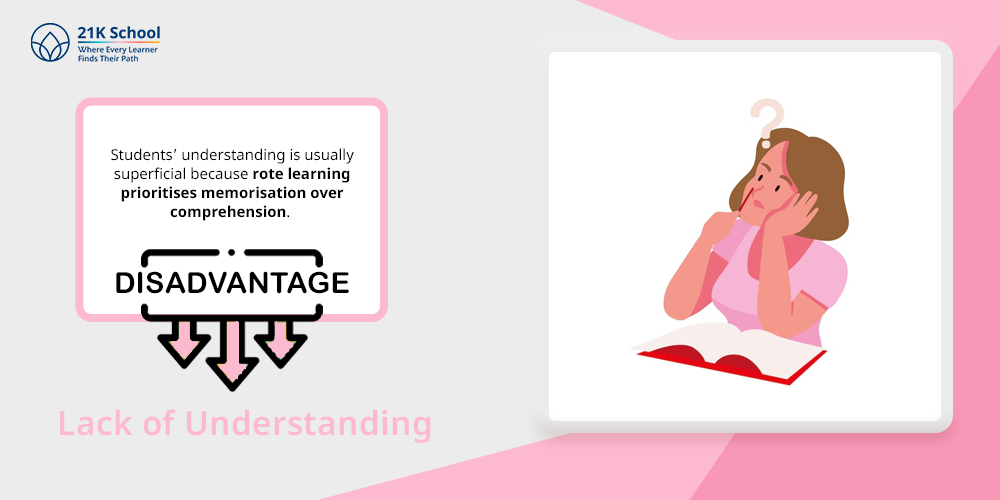
Students’ understanding is usually superficial because rote learning prioritises memorisation over comprehension.
Rote learning typically involves students recalling facts, formulas or information without comprehending the underlying concepts or the relationships between different facts.
Final Thoughts
A conventional teaching approach that stresses memorisation by repetition is called rote learning.
Although it has many benefits, such as rapid recall, streamlined learning and early education support, it also has serious disadvantages, such as the potential to impair critical thinking, creativity and long-term memory.
Rote learning works especially well for learning basic knowledge and abilities like scientific tables and vocabulary, but it might not promote a deeper comprehension of ideas or their useful applications in everyday situations.
In order to prepare students for challenges in the future, it is crucial to strike a balance between rote learning and strategies that promote comprehension and critical thinking as education advances.


